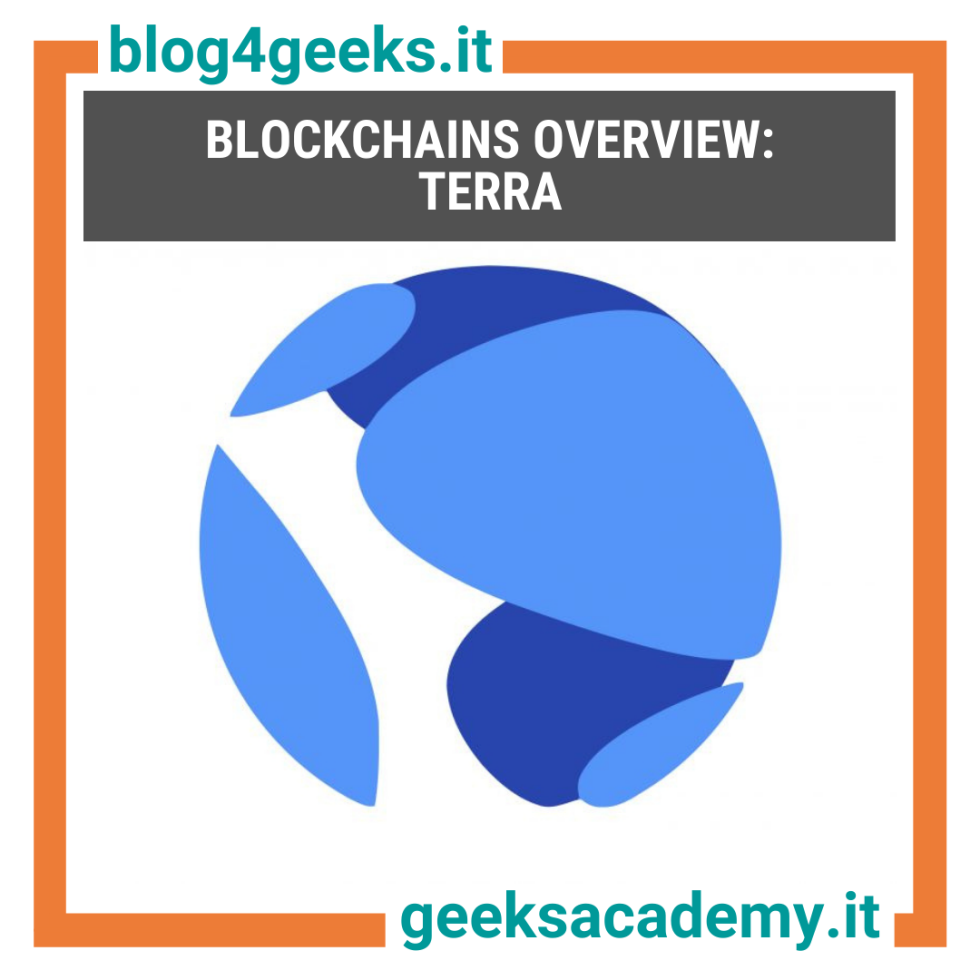
Discover Geeks Academy’s articles on: Blockchain, Coding, Cybersecurity, Cloud, Big Data, Artificial Intelligence, Gaming, Digital Innovation
Terra ecosystem was born in 2018 thanks to Daniel Shin and Do Kwon, Terraform Labs co-founders.
The project of the South Korean company Terraform Labs is to create a decentralized monetary system based on a different stablecoin from those seen so far, as the latter are still linked to a centralized economic system, as in the cases of USDT, USDC and DAI.
Decentralized and algorithmic stablecoin
Terra is a blockchain built on the Cosmos SDK and Tendermint Core. Terra’s strongest traits are interoperability and Luna/UST synergy.
The process which has led to UST’s genesis is pure innovation. The Luna token is closely connected to UST: Terra’s stablecoin peg, which is the act of “anchoring” the value, is indeed provided by the relation of those two coins. To keep the peg, there is a process in economics known as seigniorage. A standard example of seigniorage is money-printing: the cost to produce $1 banknote is $0.05, the remaining $0.95 is profit. In Terra’s blockchain, 1 UST is equal to 1$ of Luna, so the price of Luna relies on UST demand: if UST’s value falls below 1$, there is an incentive to buy UST (thus increasing its value) and convert it in 1$ of Luna, so to make a sort of arbitrage; contrariwise, if UST is worth more than $1, Luna could be converted into UST, moving the price of UST back to $1.
Previously, Luna used for seigniorage were partly destroyed (burned), where the rest were put into a community pool. Now, thanks to a governance poll, all Luna used for seigniorage are burned, therefore increasing demand and effectively creating a deflationary economic model.
However, an algorithmic stablecoin might present weaknesses, hence UST relies on its adoption and use cases. There has frequently been a tendency to underestimate the Luna/UST relation, which, in the event of major collapses, could generate the peg loss as well as the failure of the whole ecosystem.
Terra ecosystem
Terra development has been solid and constant. Chai is the most used e-commerce wallet in South Korea and allows merchants and customers to accept 20 different payment methods. Korean users use KRV, the national stablecoin, for daily transactions. Chai has generated over $2 billion in annual profits and counts over 2 million users on the platform.
In recent months, many DeFi tools landed on Terra, yet two protocols have caused interest during the ecosystem’s expansion last year: Anchor and Mirror. Anchor is a savings protocol that offers returns for stablecoin deposits. Those who deposit liquidity are incentivized through Anchor tokens (ANC). The Anchor Protocol currently has over $10 billion in Total Value Locked (TVL).
Mirror is a synthetic asset protocol which offers an exposure to different kind of assets such as commodities, ETFs, US stocks and cryptocurrencies. All assets on the platform are mAssets (Mirrored Assets) which track the price of the real underlying asset. Mirror launched in December 2020 and amassed $2.3 billion in TVL in a short period of time.
Why you should learn blockchain?
DeFi, Agrifood, IoT, Sharing Economy, Insurance, Art, Gaming, Law. Blockchain’s use cases are endless, and understanding the way to make this technology even more efficient is just the beginning. One of the most relevant field of application is the industrial sector, where countless jobs of the future could theoretically be replaced by smart contracts, oracles and AI.
Blockchain’s skills are increasingly in demand. It is not too late to start your career now: blockchain is just becoming everyday life. However, the learning curve is still steep: many companies still cannot fully understand the difference between an usual database and a blockchain, so when they turn to business advisors, their use cases are often not suitable for the technology they want to use.
Here’s what it takes:
By checking different job vacancies, this is a list of the most relevant skills and requirements:
- Understanding of algorithms, data security, decentralized technologies and data structures.
- A solid background in coding skills, with at least one of the following programming languages: Python, JavaScript, JAVA, C, C++.
- General understanding of ledgers, blockchains and cryptocurrencies.
- Expertise in performance management and anomaly detection.
- At least basic experience in building blockchain frameworks and business applications.
Don't live the future as a sidekick... be a superhero! Discover Geeks Academy’s training offer in Blockchain & Coding:
Blockchains Overview is an in-depth series about the most popular blockchains. Below a comprehensive list of the ones we have been talking about: